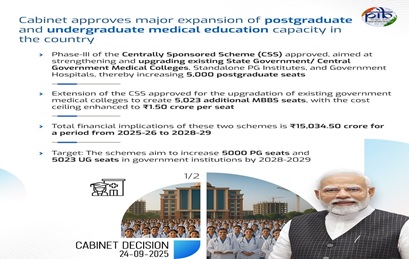28 September, 2025
Expansion of Undergraduate and Postgraduate Medical Education Capacity
Thu 25 Sep, 2025
Reference:
- The Union Cabinet, chaired by Prime Minister Shri Narendra Modi, has approved the third phase of the centrally sponsored scheme for the strengthening and upgradation of existing medical colleges/independent postgraduate institutions/government hospitals under State/Central Government, with the objective of increasing 5,000 postgraduate (PG) seats.
Background:
- Achieving Universal Health Coverage (UHC) in India requires a robust healthcare system.
- A strong healthcare system depends on adequate medical workforce (doctors, specialists, faculty).
- India currently has 808 medical colleges, the highest in the world.
- Total seats at present: 123,700 MBBS seats and 43,041 postgraduate medical seats.
- In the past decade:
- MBBS seats increased by 127% (69,352 new seats added).
- Postgraduate seats increased by 143% (43,041 additional seats added).
- Despite this growth, there remains a need to improve healthcare access and quality, particularly in rural and remote areas.
Objectives of the Scheme:
- Strengthen and upgrade government medical colleges, independent postgraduate institutions, and government hospitals.
- Increase 5,000 postgraduate (PG) seats and 5,023 MBBS seats.
- Train high-quality healthcare professionals and enhance the availability of specialist doctors.
- Ensure equitable and wide access to healthcare services.
- Align India’s medical capacity with global standards.
Financial Details:
- Total expenditure (2025-26 to 2028-29): ₹15,034.50 crore
-
- Central Government share: ₹10,303.20 crore
- State Government share: ₹4,731.30 crore
- Cost ceiling per MBBS seat: ₹1.50 crore per seat
Benefits of the Scheme:
1. Increase in availability of doctors and specialists
- Ensures quality healthcare, especially in rural and underprivileged areas.
2. Strengthening of healthcare infrastructure
- Cost-effective expansion of tertiary healthcare services in existing government institutions.
- Continuous supply of specialist doctors due to the increase in postgraduate seats.
3. Creation of human resources and employment
- Direct and indirect employment for doctors, faculty, paramedical staff, researchers, administrators, and support services.
4. Equitable distribution of healthcare services
- Promotes uniform distribution of healthcare infrastructure across states and union territories.
5. Global competitiveness and foreign exchange earnings
- With adequate and qualified doctors, India can become a major provider of affordable healthcare services, attracting international patients.
Implementation of the Scheme:
- The Ministry of Health and Family Welfare will issue detailed guidelines.
Targets:
- By 2028-29: Increase 5,000 postgraduate seats + 5,023 MBBS seats.
New Regulations:
- Faculty Eligibility Regulations 2025: Recruitment based on eligibility and merit.
- Aim: Maintain the highest academic and professional standards.
Long-Term Impact:
- Enhances healthcare capacity and quality in the country.
- Improves healthcare access in underprivileged and remote areas through equitable distribution.
- Establishes global standards for medical education and training.
- Contributes to overall socio-economic development.
Employment and Human Resource Impact:
- Provides more opportunities for medical education to students.
- Ensures adequate availability of specialist doctors and faculty.
- Strengthens human resources in the healthcare sector.
- Generates new direct and indirect employment opportunities.


















